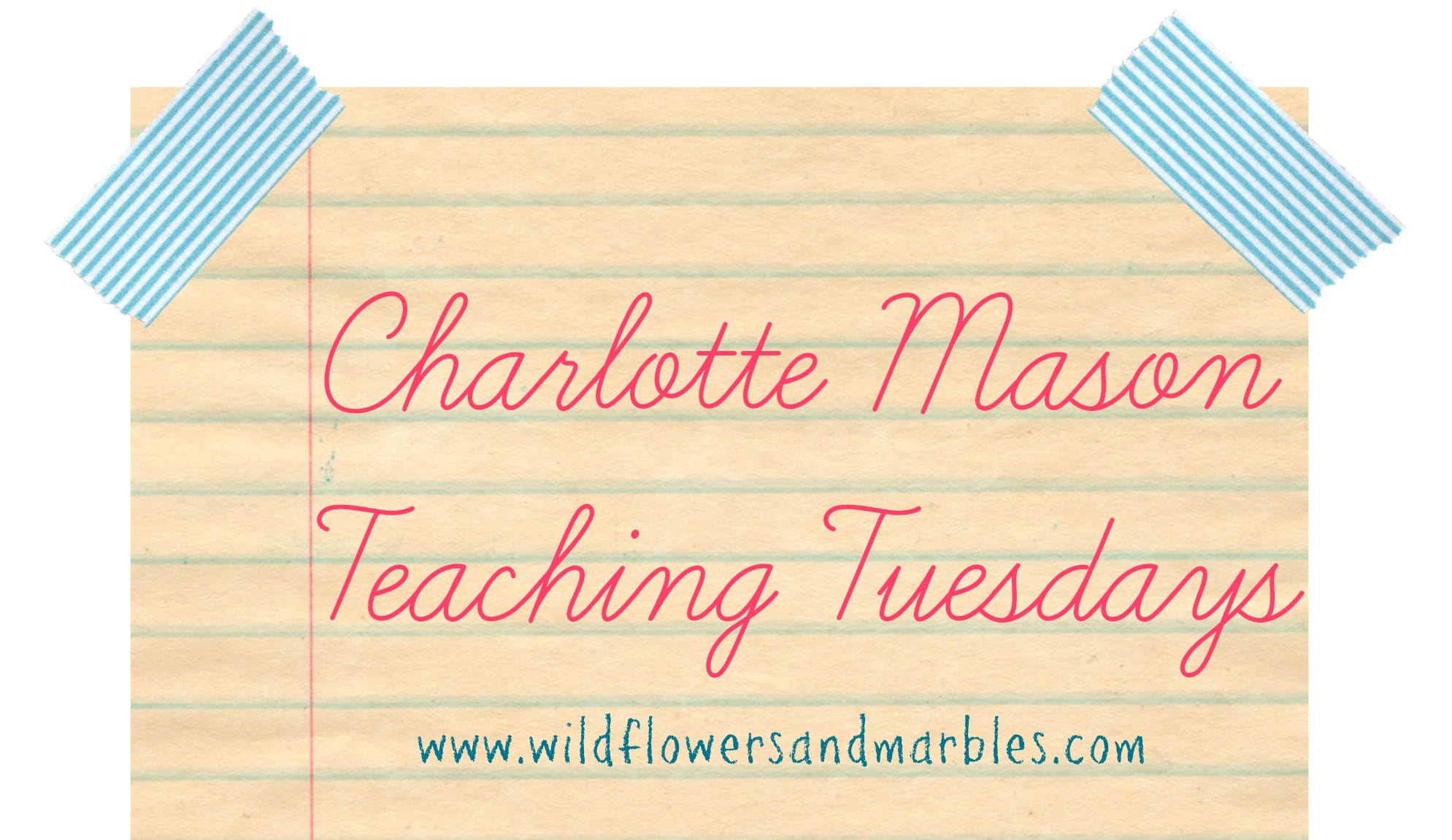Charlotte Mason Teaching Tuesday – See That He Knows – {Bonus: Silent Narrations}

How injurious then is our habit of depreciating children; we water their books down and drain them of literary flavor, because we wrongly suppose that children cannot understand what we understand ourselves; what is worse, we explain and we question. A few pedagogic maxims should help us, such as, “Do not explain.” “Do not question,” “Let one reading of a passage suffice,” “Require the pupil to relate the passage he has read.” The child must read to know; his teacher’s business is to see that he knows. All the acts of generalization, analysis, comparison, judgment, and so on, the mind performs for itself in the act of knowing.”
Have you ever met those teaching principles that seem daunting and intimidating because they’re lengthy and involve layers and layers of exacting analysis? You know an idea is worthwhile and doable when it can be broken down so simply. The child reads to know, the teacher’s job is to see that he knows.
And, always insightful and anticipating our needs for practical pegs, Miss Mason gives us a few simple maxims that act as guiding principles:
Do not explain
If you’ve ever read a favorite book a few times, then you’ll recognize that each time you do, you personally bring something new to that book and it may “speak to you” in a different way each time you read it. You’ve lived new experiences since you last read the book, or maybe your own maturity and understanding has grown and allows you to more fully sympathize with a heroine’s plight, or perhaps you sympathize with a character that in previous readings you barely noticed. So many events, experiences and deepening thoughts build within a person over time and we each bring that to our reading.
This is no different for a child. When they read a story, they bring their own unique circumstances and perspective – which will be decidedly different from our own viewpoint. And it will be decidedly literal because a young child sees literally, not abstractly. Invariably, we read a story and see morals we’d love to point out, or characters that we might identify with our child, but to explain these or to foist our own connections and observations on a child would be destructive and will undermine that child’s ability to “read to know.” They will begin to read to know you – to satisfy what they think you’re looking for. If we revisit for a moment the analogy Miss Mason likes to use of a living education as a feast of ideas, then explaining and pointing out and foisting our own observations is akin to shoveling gigantic spoonfuls of super rich, meaty food down the child’s throat – and then expecting them to be able to digest it. It’s force feeding. And it is just as unhealthy intellectually as it is physically.
One of the unique gifts of a Charlotte Mason education is that it meets the child EXACTLY where that child IS. Not where we are. Not where we think the child should be. Let the child read and know as they are. Embrace it. Avoid the impulse to explain or point out UNLESS your child asks you a question directly.
Now – to clarify – in a CM setting, the student narrated as part of a group and within that group narration, the student would also listen and be exposed to the other student’s narrations. Within this unique environment, other observations might be introduced to the child in ways that do not offend, but instead might further a narration. As a home educating mom, unless you’re reading aloud to all your children and inviting a group narration {a practice that I HIGHLY RECOMMEND you do as soon as you have more than one narrator!}, then you may wish to insert a few choice observations via the vehicle of your own narration. Does that make sense? You narrate, too. Tell your child that you noticed…. And that in the story, you saw how… Just narrate your own observations from the story – not in a pushy way that says, “you clearly missed these points.” I have to follow Our Lord’s admonition to “be like a child” when I narrate, otherwise I come across as a Pharisee. Allow wonder to imbue your own reading and narrating.
Do not question
Work on the habit of not interrupting the narration of the child. This is a VERY difficult habit to acquire but so important and worthwhile for the teacher to learn! Giving a narration is difficult business, and the student exercises their mental muscles in reading, remembering, collecting their thoughts, and giving it all back in a coherent manner. Questioning a child in the middle of a narration interrupts their work and stalls their progress in developing the habit of narration. If your student is still struggling to narrate well, ask yourself if YOU have been the cause of the delay in developing this skill? Have you been interrupting with questions?
Instead of questioning and interrupting, while your student is narrating, keep a small notebook and pencil handy and discreetly jot down questions you might have. Be careful here – if your note-taking is a distraction, you may have to work on another way to mentally remember your questions. Ask them at the end of a narration, and by all means, do so in a conversational way. Don’t quiz.
A quick word on general interruptions – consider structuring your day so that your new readers/narrators can narrate during THE MOST quiet part of your day so that their narrations can be as free from interruptions as possible. My big kids are quite adept at focusing through a multitude of distractions thanks to their younger siblings, but I value the opportunity to lay a good foundation in learning to narrate…and that means taking advantage of those quiet times and moments that might punctuate your day. Also, if your kids regularly interrupt you…or others…add it to your list of habits to work on. It seems like I’m always revisiting this one, but learning to not interrupt others is an excellent habit that serves the child throughout their life!
Let one reading of a passage suffice
Do not be tempted to go back and re-read (or let your child re-read) if your child balks at narrating. Make note of it. Brainstorm your choice of reading if your child has trouble narrating it:
- Was the selection too long? Did you assign too much reading in a day? You may have to start with one paragraph for a narration and build from there.
- Not a living book? Texty books and factual books are very hard to narrate. Some of my kids really LOVE Usborne books…but I’m not sure I consider them “living books”, and I found that out because they’re not able to be narrated.
- Way too meaty for your child to narrate? Start with good…move forward from there. Just because all the other {nebulous, un-named, bound-for-Harvard-at-10-years-old} 3rd graders you read about are reading through Montesquieu, doesn’t mean it’s appropriate for your child. You know your child best. There is a definite, objective need for a child to developmentally progress in their reading –> Mother Goose to Fairy Tales to Novels…and then Montesquieu (?). Little ideas to bigger – one day at a time. I like to stick with a general plan of one meaty-stretch-to-read book per term.
- Generally not engaging the child? This doesn’t happen often, but there have been a few books like this in our schedule over the years. This sometimes requires a little more brainstorming from me to decide if this book is “a hill I want to die on,” or if maybe I could pull this book and substitute another adequate living book on the topic at hand.
In allowing only one reading of a passage, we build the habit of attention. Of all the habits that Charlotte Mason emphasizes, the habit of full attention is probably the one she speaks of the most. And think about it, if your child learns no other habit from you except to bring full attention to a reading…and they do this over and over again…over the years…across a wide and generous curriculum…then I submit that this parent habit of attentiveness will naturally yield a variety of other fruits! Insist on it – full attention to a single reading. One little reading, one little day at a time. And there will be fruit.
Require the pupil to relate the passage he has read
Now this seems pretty obvious, and haven’t we already covered the idea of telling back in a narration, you ask? Haven’t we already pounded the idea of the student relating the passage he just read? Well…yes…but did you catch that one little word there?
– Passage –
A passage is a pretty undefined selection – it could be 3 pages, 10 pages…or it could be 1 very worthwhile paragraph. Don’t give your kids too much to read and narrate – especially your new narrators. CM said so. 😉 You might be surprised, taken aback even, by the list of books in a CM curriculum – it is wide and generous! Yet, the feast is spread out quite comfortably and moderately so that sometimes a “passage” on student’s schedule is really a very small amount. Consider the age of your child, the book to be read, the child’s reading ability, and let it be an appropriate passage – whether that’s one paragraph or one chapter.
And now…one other little word your eyes might have glanced right over…you didn’t want to see it…didn’t want to read it…it has consequences…oh no…there it is…
– Require –
Remember our original quote that illuminates a Charlotte Mason Teacher’s role? “The child must read to know; his teacher’s business is to see that he knows.” It all goes back to our authority, doesn’t it? As a CM teacher, we require a narration. It’s HOW we can “see that he knows.” Now…there are so many ways to narrate! So, do be creative here!
- Oral narrations
- Written narrations
- Silent narrations {read about that immediately below!}
- CM Notebooks – these make a very valuable vehicle for narrating and “relating the passage”
- Poetry narrations – I haven’t talked about these before…mainly because my children don’t narrate in this manner, but pick up CM’s Volume 6 and it’s one of the first thing that strikes you about her children’s work: they narrate via poetry all.the.time. It’s one of those things on my CM list that I really want to explore.
- Artistic interpretations – little children love to act things out through puppet shows, original artwork (drawings, paintings).
- The secondhand narration – ok, moms…don’t underestimate the value of over-hearing your 2nd grader telling your Kindergartner about John Henry or Paul Bunyan or Babe the Big Blue Ox! It counts! I’m just sayin’ – we home educating moms with a few kids have to take advantage of authentic and creative ways to “see that he knows.” I learned a couple of kids ago, that the second hand narration is legit! If you needed validation, consider yourself affirmed! 🙂
{Bonus} Silent Narrations
Immediately following the above selection from Charlotte Mason’s Philosophy of Education, Miss Mason describes a mental exercise that has the potential for transforming your upper level students’ narrations! Miss Mason illustrates how “the mind performs for itself the act of knowing” —
If we doubt this, we have only to try the effect of putting ourselves to sleep by relating silently and carefully, say, a chapter of Jane Austen or a chapter of the Bible, read once before going to bed. The degree of insight, the visualization, that comes with this sort of mental exercise is surprising.”
In reading this, we can see exactly how to step an older student through the mental exercise of a silent narration.
I discovered quite accidentally that my older students were narrating silently. I had become so busy – trying to keep up with littles, another pregnancy, growing children…and keeping up with narrations became something I valued so much…but there was only so much time in a day…and I couldn’t always invite a narration, from every child, immediately after they read a book. In fact, at that time, I had gotten in the habit of catching up on my older kids’ narrations at the end of the week – it was like a marathon session of “narrate every book you read from this week while I make eggs and biscuits for dinner.” Probably not one of my finer CM teaching moments! 🙂 Anyway, one day, I asked my daughter how she could narrate her reading so well when it had sometimes been 5 days since she’d read a book. She answered that she would sometimes just narrate to herself right after she read something, and that allowed her to remember and be able to narrate to me at a later time. KA-CHOW Talk about a lightbulb moment for me! I was so excited to know she was doing this and ever since then, I’ve been looking for references to this skill of silent narrations in Miss Mason’s writings. It is alluded to here and there, and the above quote is probably the best illustration of HOW to go about doing it.
I suppose you could try to begin developing this with elementary students, but my own thought is that this is best developed {almost intuitively as my daughter’s example illustrates} by an older student for whom the skill of narrating has fully developed. I view those early years as the most valuable time for setting habits like oral narration, and the middle and high school years are for building on those habits with written and silent narrations. So…consider working with your middle schoolers and high schoolers that are already capable and excellent narrators.
In following Miss Mason’s example, here are the finer points of this mental exercise:
- Read at a quiet time {before bed, quiet afternoon}.
- Read the selection once.
- Silently and carefully, {narrate} tell the reading back to yourself – this is done interiorly.
- Visualize yourself within the reading; allow yourself to mentally step into the reading.
- Continue to narrate to yourself while visualizing the story/passage read.
If you or your child can do this, you’ve just narrated silently. And it has the same effect as an oral or written narration – cementing knowledge. It is very much a legitimate form of narration. The silent narration is an EXCELLENT tool in the home educating mom’s toolbox – so begin to develop this skill with your narrators! If you do, I think you’ll find you can free up some time on your schedule and in your day without compromising one of the cornerstones of a Charlotte Mason Education – the narration!







Another great post, Jen! I have, unfortunately, allowed the busy-ness of life to take the place of narration in our homeschool. I know it’s value though and have committed myself to building this skill into our homeschool day as a vital part instead of an “if-there-is-time-for-it” part! Taking notes from this great post to help me out with my commitment! 🙂
Thanks, Becky! A Mother’s life and vocation is never static, particularly in the area of home education – so I’m always looking again, reconsidering how we do something, when we do something, what it looks like. For me, summer is a great time for looking back with the purpose of moving forward. Sounds like you’re in the same boat! Happy summer planning to you!
Just narrate your own observations from the story – not in a pushy way that says, “you clearly missed these points.” I have to follow Our Lord’s admonition to “be like a child” when I narrate, otherwise I come across as a Pharisee. Allow wonder to imbue your own reading and narrating.
This is what i’ll be working on… I have slipped away from this habit. How valuable it is for our children to see us learning and processing alongside them.
Thank you for the reminder!
~lisa
Long time reader here…but I am afraid I have left few comments. However, I was just reading the latest post over on the Charlotte Mason Institute and they have put up an extract from a 1926 Parents’ Review article written by Elsie Kitching (http://www.charlottemasoninstitute.org/notes-and-queries-by-elsie-kitching/). In it, she discusses silent narration and, I thought that is exactly what Jenn wrote about recently! Just in case you hadn’t seen it I thought I would bring it to your attention.
Here is the relevant passage:
“(3) “How can the Mason system be used successfully in a group made up of three or more classes, all the children of which are below the fourth grade? There seems to little time for narration in proportion to the amount of reading it is possible to do, and the children are not yet able to write easily.”
Narration must be considered from two points of view. It is the teacher’s test of a child’s knowledge either orally, or in writing, but is also the process by which child or adult gains knowledge and makes it his own. It is expressed silently, orally, or in writing. “We narrate and then we know,” said a little girl to a Government Inspector. She had been brought up in a large school working out the P.U.S. programmes and was accustomed to narration in the three kinds above mentioned. Every child cannot narrate aloud every lesson, nor is it necessary. The teacher’s part is to see that the children are trained to work by one reading with narration to follow. The teacher may test it in various ways, some of which are indicated in a paper (see answer 7) by the headmaster of a large boys’ school; but a slavish adherence to the letter rather than the spirit even in this matter of narration will only court disaster. Clever children will sometimes memorise an astonishing amount and will not understand what they have read or narrated. Here again the teacher must test the narration by a wise question which will lead to a discussion and will see to it that next time the passage is too long to allow of verbal memory.”
Thrown into “school at home” due to school closures, we struggled with narrations this week. This post has helped me a lot! I was making so many mistakes! Thank you again, for taking the time to share your knowledge.
I am so glad you found some help here – truly! Just keep doing your best!